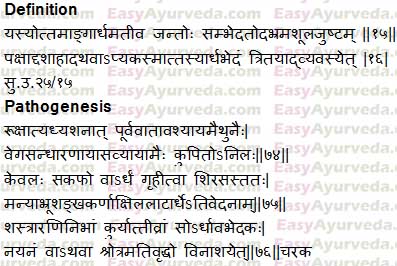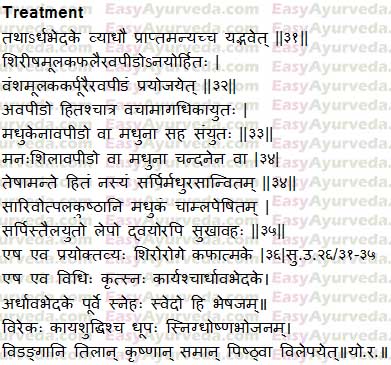Ardhavabhedaka Shiroroga – Causes, Symptoms, Treatment
By Dr Raghuram Y.S. MD (Ay) & Dr Manasa, B.A.M.S
Ardhavabhedaka is one of the types of headache which manifests in half portion of the head. Read about Migraine and Ayurveda treatment
Table of Contents
Definition
Meaning and definition of Ardhavabhedak Headache
Ardha = half side of the head
Avabhedaka = penetrating / splitting / bursting / breaking pain
Headache in which there is bursting pain on one half of the head is called ardhavabhedaka.
Causes
Ardhavabhedaka headache is caused by simultaneous vitiation of all three doshas. Below mentioned are its causes –
- all causes including foods and life activities which cause aggravation of all three doshas
- general etiological factors mentioned for causing headaches
Causes mentioned by Master Charaka –
- Excessive consumption of dry foods
- Consumption of excessive food
- Exposure to breeze and fog / mist
- Excessive indulgence in sex
- Forcible withholding of natural body urges / reflexes
- Excessive indulgence in physical activities / exercise
- Excessive exhaustion
Read – Tension Headache Ayurvedic Treatment, Remedies, Tips, Herbs
Pathogenesis
Vata gets vitiated by the above said etiological factors. Vata either individually or with vitiated kapha gets lodged in half portion of the head. The doshas then cause headache called ardhavabhedaka. The pain is very severe and intolerable. When this disease is not promptly treated and when the disease progresses, it consequentially makes one blind and deaf.
Thus, ardhavabhedaka headache might manifest in two forms –
- Predominantly caused by vitiated vata
- Predominantly caused by vitiation of both vata and kapha
The symptoms and pathogenesis too will be in accordance to the doshas involved. Similar is the opinion of master Madhava.
Pathogenesis as stated by master Videha
The vata aggravated in any one side of the head on getting blocked by morbid kapha causes headache. The episodes of headache occur once in 3, 5, 15 or 30 days.
Shirastapa v/s ardhavabhedaka
Master Vagbhata opines that this disease is caused by predominant vitiation of vata alone. If headache manifests in the entire head it is called as shirastapa. If it occurs on one half of the head it should be called as ardhavabhedaka.
Symptoms
- Splitting / blasting / breaking type of severe pain in half side of the head
- Throbbing pain in the afflicted part of the head
- Giddiness / fainting / loss of consciousness / dizziness
- Pain as if injured by a sharp weapon or thunderbolt in the sides of the neck, eyebrow, temple, ear, eye and forehead of the afflicted half of the head
- Blindness
- Deafness
- The symptoms occur without any cause, suddenly, as episodes once in 15 days or 10 days.
Tentative modern correlation
Ardhavabhedaka headache has been compared to ‘migraine’ headache explained in the modern texts.
Sanskrit Verse


Treatment
Treating on the lines of Suryavarta headache – Ardhavabhedaka headache shall be treated on the lines of suryavarta headache. It should be treated after duly considering the dosha, region in which the patient lives, time of treatment and other relevant factors.
Avapidana Nasya – Nasal instillation of medicaments
The below mentioned herbs should be ground and their juice pressed into the nostrils as drops –
- Shirisha – roots and fruits of Albizia lebbeck
- Vamshamuladhya avapidana – roots of bamboo and camphor
- Vacha Pippali avapidana – powder of Acorus calamus and long pepper
- Yashtimadhu – licorice powder mixed with honey
- Chandana – sandalwood powder with honey
- Manashila – Realgar powder
Ghee errhines – After administering the above mentioned errhines, nasal drops using ghee prepared with paste and decoction of sweet tasting herbs of Kakolyadi Gana group is beneficial.
Lepa – Anointment with paste of Hemidesmus indicus, blue lotus, licorice and Sausuurea lappa ground with fermented herbal liquid, mixed with ghee and oil is beneficial.
Treatment protocol of Ardhavabhedaka headache according to Yogaratnakara treatise
Snehana – initially oleation should be administered to the patient. Here he is made to drink metered doses of medicated ghee every day. This will destroy the dosha induced excessive dryness inside the body.
Swedana – following oleation, sudation is administered. The doshas which have got blocked in the body channels will get loosened. These liquefied doshas will move towards the stomach.
Virechana – the doshas reaching the stomach following oleation and sudation should be expelled by administration of purgation.
Shirovirechana – the morbid doshas blocked in the head should be purified by administration of strong acting errhines. Herbs like Acorus calamus etc should be used.
Asthapana and Anuvasana – decoction and fat enemas should be administered after purifying the body and head.
By all the above said measures the entire body and head will be purified. This is essential for the next set of interventions.
Dhumapana – medicated smoking shall be administered to palliate the vata and kapha doshas in the head, nose and mouth.
Snigdhoshna bhojana – After medicated smoking, the patient shall be served with hot and unctuous foods.
Dugddha sharkara – sugar should be mixed in the milk and administered to drink through nose or mouth.
Vidangadi Lepa / Nasya – equal quantity of Embelia ribes and sesame should be ground in goat’s milk. This should be used as anointment of nasal drops.
Other remedies
Kshirini bindu – the pulp of three seeds of Argemone mexicana should be ground in water and paste prepared. This paste should be pressed so that the drops are instilled into the nostril. Drops should be instilled in the opposite nostril as the side of headache. This should be done before sunrise.
Goat milk – compress / sponging of head shall be done with goat’s milk.
Medicines for Shiroroga From Sahasra Yoga Text Book
Mashadi Taila
Triphaladi Taila
Asanabilwadi Taila
Manjishtadi Taila
Bala Hathadi Taila
Bala Dhatryadi Taila
Tungadrunadi Taila
Amrutadi Taila
Kacchuradi Choorna (brihat)
Nasika Choorna
Korit Talam
Shirastoda Gutika
Villam Pacchotyadi Taila
Kayyonyadi Taila
Jati Manyaladi Taila
Click to Consult Dr Raghuram Y.S. MD (Ayu) – Skype








